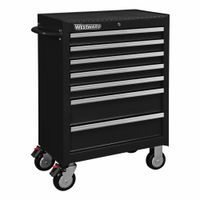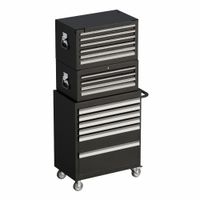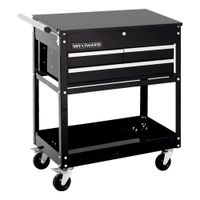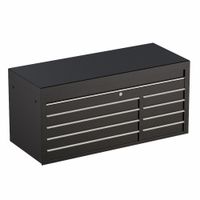Call +(254) 703 030 000 / 751 483 999 / 721 704 777
- Home
- Tools
- Tool Storage
- Tool Cabinets Chests Carts
.....Read More
Frequently Asked Questions
What is the best tool cabinet for a small workshop?
The best tool cabinet for a small workshop is the Husky 27 in. 5-Drawer Tool Cabinet. This cabinet offers a balance of durability, storage capacity, and affordability, making it ideal for compact spaces.
Key features include:
1. **Size and Portability**: With dimensions of 27 inches in width, it fits well in small workshops without consuming excessive space. The cabinet is equipped with swivel casters, allowing easy mobility around the workshop.
2. **Storage Capacity**: It has five drawers of varying depths, providing ample storage for different tool sizes. The top drawer is shallow for small tools and accessories, while the bottom drawers are deeper, accommodating larger tools.
3. **Durability**: Constructed from heavy-duty steel, it ensures long-lasting use. The drawers are supported by ball-bearing slides, allowing smooth operation even when fully loaded.
4. **Security**: The cabinet features a central locking system, ensuring tools are secure when not in use.
5. **Work Surface**: The top of the cabinet can double as a work surface, adding functionality to the limited space in a small workshop.
6. **Affordability**: Compared to other high-end brands, the Husky cabinet offers excellent value for money, providing essential features without a hefty price tag.
Overall, the Husky 27 in. 5-Drawer Tool Cabinet is a practical choice for small workshops, offering a combination of space efficiency, robust construction, and cost-effectiveness.
How do I organize tools in a tool chest?
To organize tools in a tool chest effectively, start by emptying the chest and categorizing your tools. Group them by type or function, such as wrenches, screwdrivers, pliers, and power tools. This helps in identifying what you have and what you might need.
Next, clean the tools and the chest to ensure everything is in good condition. Consider using drawer liners to prevent tools from sliding and to protect the chest from scratches.
Assign each drawer or section of the chest a specific category of tools. Place frequently used tools in the top drawers for easy access, while less frequently used items can go in lower drawers. Use foam inserts or tool organizers to keep tools in place and prevent them from moving around.
Label each drawer or section clearly to make it easy to find and return tools. This can be done with a label maker or by using adhesive labels.
For small items like screws, nails, and bits, use small containers or bins. Magnetic strips or pegboards can be attached to the inside of the chest lid or on the sides for additional storage of metal tools.
Consider the weight distribution; heavier tools should be stored in the lower drawers to prevent the chest from tipping over. Keep similar tools together, and avoid overcrowding to maintain visibility and accessibility.
Regularly review and reorganize the tool chest to accommodate new tools and discard or replace damaged ones. This ensures that your tool chest remains efficient and functional over time.
What are the benefits of a rolling tool cabinet?
A rolling tool cabinet offers several benefits that enhance organization, efficiency, and mobility in various work environments:
1. **Mobility**: The primary advantage of a rolling tool cabinet is its mobility. Equipped with wheels, it allows for easy transportation of tools across different work areas, reducing the need to carry heavy tools manually and minimizing downtime.
2. **Organization**: These cabinets typically come with multiple drawers and compartments, enabling users to organize tools systematically. This organization facilitates quick access to tools, improving workflow and productivity.
3. **Space Efficiency**: Rolling tool cabinets help maximize workspace by providing a compact storage solution. They can be easily moved and stored under workbenches or in corners when not in use, freeing up valuable floor space.
4. **Durability**: Constructed from robust materials like steel, rolling tool cabinets are designed to withstand heavy use and harsh environments, ensuring long-term durability and protection for tools.
5. **Security**: Many rolling tool cabinets come with locking mechanisms, providing security for valuable tools and equipment. This feature is particularly beneficial in shared workspaces or job sites where tool theft can be a concern.
6. **Customization**: These cabinets often offer customizable options, such as adjustable shelves and removable trays, allowing users to tailor the storage to their specific needs and preferences.
7. **Ergonomics**: By keeping tools organized and within easy reach, rolling tool cabinets reduce the need for excessive bending or stretching, promoting better ergonomics and reducing the risk of injury.
8. **Professional Appearance**: A well-organized rolling tool cabinet presents a professional image, which can be important for businesses that value neatness and efficiency in their operations.
Overall, a rolling tool cabinet is a versatile and practical investment for anyone who requires efficient tool storage and mobility.
How do I maintain and clean a tool cart?
To maintain and clean a tool cart effectively, follow these steps:
1. **Organize Tools**: Regularly sort and organize tools by type and size. Use drawer liners or dividers to keep them in place and prevent damage.
2. **Inspect Tools**: Check for any damaged or worn-out tools. Repair or replace them as necessary to ensure safety and efficiency.
3. **Clean Tools**: Wipe down tools with a clean cloth. For stubborn dirt or grease, use a mild detergent or degreaser. Dry tools thoroughly to prevent rust.
4. **Clean the Cart**: Empty the cart and vacuum any debris. Use a damp cloth with mild soap to wipe down the surfaces. Pay attention to corners and crevices where dirt accumulates.
5. **Lubricate Moving Parts**: Apply lubricant to the wheels, hinges, and drawer slides to ensure smooth operation. Use a silicone-based lubricant for best results.
6. **Check Fasteners**: Tighten any loose screws, bolts, or nuts on the cart to maintain its structural integrity.
7. **Rust Prevention**: Apply a rust inhibitor to metal parts of the cart and tools. Store the cart in a dry area to minimize moisture exposure.
8. **Label Drawers**: Use labels to identify the contents of each drawer for easy access and organization.
9. **Regular Maintenance**: Set a schedule for regular cleaning and maintenance, such as monthly or quarterly, depending on usage.
10. **Safety Check**: Ensure that the cart is stable and that the wheels lock securely to prevent accidents.
By following these steps, you can keep your tool cart in excellent condition, ensuring it remains a reliable and efficient part of your workspace.
What features should I look for in a tool chest combo?
When selecting a tool chest combo, consider the following features:
1. **Material and Durability**: Opt for high-quality materials like heavy-duty steel or aluminum for longevity and resistance to wear and tear.
2. **Size and Capacity**: Ensure the chest can accommodate your current tools and allow room for future additions. Consider the number of drawers and their depth.
3. **Mobility**: Look for chests with sturdy casters for easy movement. Locking wheels are beneficial for stability when stationary.
4. **Drawer Slides**: Choose ball-bearing slides for smooth operation and better weight handling compared to friction slides.
5. **Locking Mechanism**: A reliable locking system is crucial for security. Consider chests with keyed locks or combination locks.
6. **Drawer Liners**: These prevent tools from sliding and protect the drawer surface. Some chests come with pre-installed liners.
7. **Weight Capacity**: Check the maximum weight each drawer can hold to ensure it meets your needs.
8. **Modularity**: Some combos offer stackable or expandable options, allowing you to customize your storage as needed.
9. **Ergonomics**: Look for features like comfortable handles and easy-to-open drawers to enhance usability.
10. **Finish and Corrosion Resistance**: A powder-coated finish can protect against rust and corrosion, extending the life of the chest.
11. **Brand Reputation and Warranty**: Consider brands known for quality and customer service. A good warranty can provide peace of mind.
12. **Price**: Balance your budget with the features you need. Sometimes investing a bit more upfront can save money in the long run.
13. **Additional Features**: Some chests offer power strips, USB ports, or pegboards for added convenience.
Evaluate these features based on your specific needs and workspace to find the best tool chest combo for you.
How do I secure my tools in a tool cabinet?
To secure your tools in a tool cabinet, start by choosing a high-quality cabinet made of durable materials like steel, which offers better protection against forced entry. Opt for a cabinet with a robust locking mechanism, such as a key lock, combination lock, or electronic lock, to prevent unauthorized access.
Organize your tools efficiently using foam inserts or custom-cut tool organizers to keep them in place and reduce the risk of damage. Label each section to ensure tools are returned to their designated spots, maintaining order and making it easier to notice if anything is missing.
Install the cabinet in a secure location, ideally in a locked garage or workshop, away from windows and doors to minimize visibility to potential thieves. Anchor the cabinet to the wall or floor using bolts or brackets to prevent it from being moved or tipped over.
Consider adding an alarm system or motion sensor lights around the cabinet area to deter intruders. For added security, use a surveillance camera to monitor the space, providing evidence in case of theft.
Regularly inventory your tools, keeping a detailed list with descriptions, serial numbers, and photographs. This documentation can be invaluable for insurance claims or police reports if tools are stolen.
Finally, limit access to the cabinet by sharing the key or combination only with trusted individuals. Regularly update the lock combination or change the locks if you suspect unauthorized access. By implementing these measures, you can effectively secure your tools in a tool cabinet.
What is the difference between a tool chest and a tool cabinet?
A tool chest and a tool cabinet are both storage solutions for tools, but they differ in design, capacity, and functionality.
A tool chest is typically a portable storage unit, often with a handle, designed to be carried or moved easily. It usually consists of multiple drawers and compartments to organize tools of various sizes. Tool chests are often made of metal or durable plastic and are ideal for personal or small-scale use. They are compact, making them suitable for home garages or small workshops. Tool chests can be placed on top of tool cabinets for additional storage.
In contrast, a tool cabinet is a larger, stationary storage unit, often on wheels for mobility within a workspace. It is designed to hold a more extensive collection of tools and equipment. Tool cabinets usually have multiple drawers and may include a work surface on top. They are often made of heavy-duty metal to support the weight of numerous tools. Tool cabinets are ideal for professional settings or larger workshops where a more extensive tool collection needs to be organized and easily accessible.
In summary, the primary differences lie in their size, portability, and intended use. Tool chests are portable and suitable for smaller tool collections, while tool cabinets are larger, stationary, and designed for more extensive storage needs.




